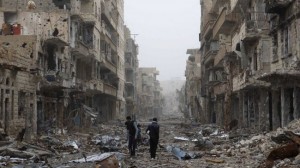 The degraded situation of the Syrian military after two and a half years of war may mean it is more vulnerable to limited US missile strikes than some western officials have been suggesting.
The degraded situation of the Syrian military after two and a half years of war may mean it is more vulnerable to limited US missile strikes than some western officials have been suggesting.While there has been widespread scepticism from military sources over the effect of the suggested air strikes, former Syrian military officers and some analysts believe even limited strikes might cause significant damage.
The view was shared by a report last week from the Rand Corporation thinktank, Options for Airpower in Syria. It argued that neutralising Syria's air defences and severely damaging its air force were likely to be much easier than some pessimists suggested.
Although it argued that "negating Syrian air power would have only a marginal direct effect on civilian casualties, which have mostly been caused by ground forces", it said this "could significantly assist Syrian opposition forces by denying air support and especially air mobility and resupply to the Syrian�army".
The report was far more sceptical about the ability of US cruise missile strikes to knock out Bashar al-Assad's chemical capability. "The practical options for doing so have serious limitations, and attempting it could actually make things worse. Locating all Syrian chemical weapon facilities and defining them well enough to design effective conventional air strikes against them would require very precise and detailed intelligence."
The view that Assad's conventional forces are vulnerable was endorsed by a Syrian air force defector in Jordan, interviewed by the�Observer, who suggested that the regime's forces are more stretched than some analysts have suggested and are dangerously exposed in a number of key areas.
While the Syrian air force has been described as being on "its last legs", with crews cannibalising aircraft to keep planes in the air, other factors are likely to be problematic for the regime.
"They have been moving people out of security compounds," the defector said, repeating the claim made by others that prisoners and civilians had been moved into the vacated bases.
"But there are other locations that they can't evacuate. They rely on holding the big bases like Mezze. They can't abandon them.
"They will have to keep their forces manning the main supply routes and that makes them vulnerable to attack.
"I served at Mezze. The bunkers for personnel are not very good. We used to nickname them the graves and talk about how � in a crisis � we'd rather take our chances in the open than get buried in them."
He said he did not believe that the shelters available for hiding aircraft were well enough hardened to sustain a hit from a cruise missile. "There are no underground bunkers. The hangars we have in the open are reinforced but no match for modern weapons."
The detailed depiction of Syrian military resilience painted a picture of largely antiquated equipment, difficulties in moving supplies and a vulnerable communications network.
"There is a buried cable system connecting all the large bases, and a new North Korean communication system that was installed last year, designed to jump from band to band if one is compromised. But a lot of the systems for communication with aircraft are based on old-fashioned radio handsets."
He said that in some locations his network of defectors had calculated that strikes on as few as three locations � as in the case of Deraa � would allow opposition fighters to move in.
"We have supplied the locations of what we think are the key targets. The [Free Syrian Army] is ready if they are taken out.
"In addition the aircraft that the regime does have available are old. Many of the newest operating are from the 1990s. There are places where there should be six jets operating but they can only fly two. Our sources tell us they have only 60 pilots available and 40 helicopter crews. But because the opposition doesn't have aircraft that is still a big advantage. Any damage to these aircraft would cause severe damage to the regime's capability.
"The other advantage that they have is long-range weapons. They have Scuds and another missile with a shorter range."
There were reports earlier in the week that US cruise missiles would likely be aimed at the Syrian command and units associated with alleged chemical weapons attacks rather than chemical storage sites.
According to the�New York Times�that would include headquarters and rocket and artillery units involved in launching the attacks.
According to one US official quoted by the paper, the initial targets being considered include fewer than 50 sites, but significantly those air bases where Syria's Russian-made attack helicopters are deployed.
By The Guardian
The Iran Project is not responsible for the content of quoted articles.










